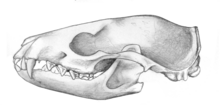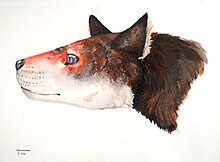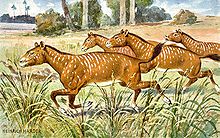Gustafsonia
| Gustafsonia Temporal range:
Early Oligocene | |
|---|---|

| |
| Scientific classification | |
| Domain: | Eukaryota |
| Kingdom: | Animalia |
| Phylum: | Chordata |
| Class: | Mammalia |
| Order: | Carnivora |
| Family: | †Amphicyonidae |
| Genus: | †Gustafsonia Tomiya & Tseng, 2016 |
| Species: | †G. cognita
|
| Binomial name | |
| †Gustafsonia cognita (Gustafson, 1986)
| |
| Synonyms | |
| |
Gustafsonia is an extinct
Morphology
Fossil
The holotype is missing the mandible, upper canines, and zygomatic arch. The remainder of the skull is damaged, but relatively intact.
Teeth
It preserves the old style of many teeth, probably having forty-two, as compared to most modern carnivorans in the low thirties. With the later species of Miacis, the size of the certain teeth were decreasing, namely the foremost


Comparison to modern species
The skull of G. cognita is long and low. In skull morphology, the African palm civet, Nandinia binotata takes the prize of looking most like its distant relative.
Digital morphology and CT scanning
The information core for the Digital Morphology library is generated using a state-of-the-art high-resolution X-ray computed tomographic (X-ray CT) scanner. This instrument is comparable to a conventional medical diagnostic CAT scanner, but with greater resolution and penetrating power. The CT scanner was custom built and optimally designed to explore the internal structure of natural objects and materials at mega- and microscopic levels. This instrument is at the center of The University of Texas High-Resolution X-ray Computed Tomography Facility (UTCT), a designated NSF-supported Multi-User Facility. Now in its seventh year, UTCT has scanned hundreds of rocks, meteorites, fossils, and modern organisms, providing unique data and visualizations for a wide range of interests in education and research.
The holotype of Gustafsonia cognita was made available to the University of Texas High-Resolution X-ray CT Facility for scanning by Dr. Timothy Rowe of The University of Texas at Austin, Department of Geological Sciences. The specimen was scanned by Richard Ketcham on 3 December 2007 along the coronal axis for a total of 1010 slices. Each 1024×1024-pixel slice is 0.08551 mm thick, with an interslice spacing of 0.08551 mm and a field of reconstruction of 40 mm.[4]
Surface views allow one to roll, pitch, and yaw the specimen to see the fossil as though you were holding it in your hand. A second series is much more in depth slice movies, with coronal, transverse, and sagittal slices of the fossil. The last series is a dynamic cutaway from coronal, transverse, and sagittal angles as well.

Evolution
The
Ecology


Reeves bonebed is well known for its
References
- PMID 27853569.
- ^ "Miacis cognitus Gustafson 1986 (carnivoran)". Paleobiology Database. Archived from the original on March 25, 2012.
- ^ Digimorph (Digital morphology). "Miacis cognitus, extinct carnivoran".
- ^ University of Texas, Austin. "Reeves bonebed".
